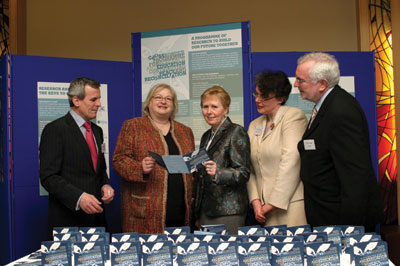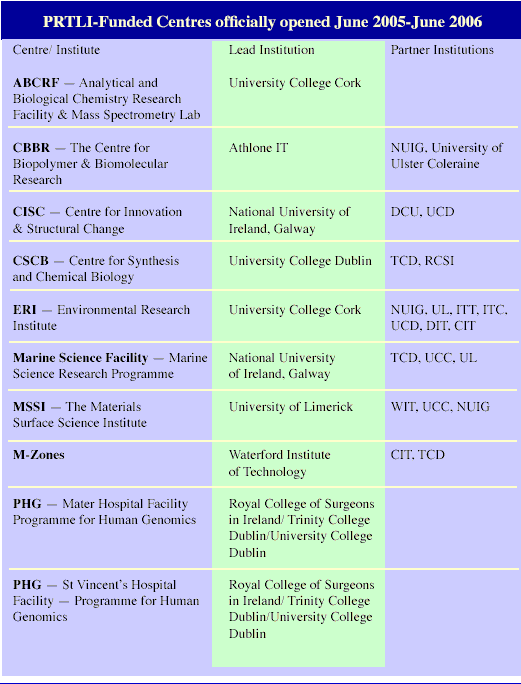| 2006 |

|
YEAR BOOK |
Higher Education Authority
|
HEA PRTLI — high impact year
|

The impact of the PRTLI has been felt in twenty-seven third-level institutions, with nearly fifty research programmes, encompassing thirty-three research centres, being established.
The views of those at the coal-face all over Ireland are striking. Dr Edmond Magner, Director of the Materials and Surface Science Institute at the University of Limerick, reports: "We now have a dedicated research infrastructure that can stand […] with any other facility that I have come across internationally. We have 205 researchers working in the Institute— in 1999 we had 20 academics, we now have 34; the number of post-docs has grown from 5 to 38, while we have 120 PhDs compared to 75 six years ago."
Similarly, Dr John Bartlett, Director of Research at Sligo Institute of Technology, comments: "PRTLI has had a major impact on the Institute. Recently we were given the go-ahead to award our own Ph.D.s— that would not have happened without this investment."
The views of Dr Florence McCarthy of the PRTLI-funded Analytical and Biological Chemistry Research Facility at UCC are no doubt echoed in many quarters. He remarks: "I'm ecstatic to be a scientist. I couldn't imagine myself being anything else because each day I jump out of bed to come to work and I know I can make a difference."
Ireland is now seen as an exciting place to do research with a much improved infrastructure. This has not only given a huge boost to the morale of the institutions and the researchers involved, but it has been of major importance in assisting the institutions in attracting funding from a range of other national and international sources.
In the Impact Assessment of the PRTLI published in 2004, it was estimated that an additional €250 million had been earned by the institutions. That trend has continued to date with significant funds being secured.
Examples of this include UCD's Conway Institute, which has secured in excess of €9 million from agencies, such as the Health Research Board and Science Foundation Ireland, from the European Sixth-Framework Programme, and from other sources. Similarly, UCC's Analytical and Biological Chemistry Research Facility has established a strategic link with Waters/Micromass, and substantial additional investments are being made in the areas of biosciences, food and health, and nano-science.
Investments from the Health Research Board, Science Foundation Ireland and the European Sixth-Framework Programme are also to be found in the RCSI and in UCD's Centre for Synthesis and Chemical Biology (CSCB).
The CSCB at UCD was opened in 2006 by Taoiseach Bertie Ahern. It is a 2,300 m 2 building comprising six state-of-the-art laboratories for synthetic chemistry, and mass spectrometric and nuclear magnetic resonance (NMR) spectroscopic facilities. The UCD-led collaboration with TCD and the RCSI, which was funded by a grant of just under €26 million, is the largest single investment in chemistry research made by the Irish Government, and represents a significant platform for the creation of "fourth-level Ireland". The development of a "fourth-level sector" is seen as essential if we are to produce the knowledge leaders and the climate of innovation requisite for Ireland's future economic growth.
Similarly, the Environmental Research Institute at UCC had its official opening by Mr Dick Roche TD, Minister for the Environment, Heritage and Local Government in 2006. The entire building is part of a sustainable building research project run by the Department of Civil and Environmental Engineering and it incorporates, on a large scale, "green building" initiatives such as geothermal heating, solar panels and heat exchangers.
Environmental science research has been strongly supported under the PRTLI, with over €60 million in total being allocated to institutions in Ireland. A total of 320 researchers are now employed pursuing vital investigative work that will play a major role in building an improved and sustainable future for Ireland and the world generally. Funding of the order of €27 million has been provided under the PRTLI for the Environmental Research Institute.
Linkages with industry are a key component of PRTLI projects, and in Athlone Institute of Technology, the Centre for Biopolymer and Biomolecular Research (CBBR) is working closely with medical device and diagnostics companies.
The Centre, which was officially opened in the last year, builds on two of the Institute's main strengths—toxicology and polymer engineering—and provides space and resources to support more than twenty researchers. The interface and synergy between multidisciplinary teams is considered to be crucial for the development of new biomaterials and the biological exploitation of polymers. To facilitate these developments the CBBR is acquiring state-of-the-art equipment, including robotic work stations, real-time quantitative polymerase chain reactors (PCR), high-through-put plate readers, fast protein liquid chromatography gene expression microarray technology, and µTA (thermal analysis) and surface microscopies.
An on-line guide to PRTLI-funded centres is available at www.hea.ie/PRTLI . The interactive map groups the research programmes funded by the Programme for Research in Third-Level Institutions (PRTLI) under five thematic areas: biosciences and biomedicine, environment and natural resources, physical sciences and technology, social sciences and humanities, and library. The interactive guide displays the geographical dispersion of PRTLI funding. Further information on each funded centre is available by following the link to the centre's own website.

IReL - Irish Research Library
Support for Irish researchers continues to improve and the expansion in 2006 of IReL—the Irish Research Library—to cover not only the fields of biotechnology and information communications technology, but also the humanities and social sciences, has been described by users as "improving the information infrastructure for researchers out of all recognition".
Researchers and students in Irish higher-education institutions now have online access to more than 25,000 academic journals thanks to this major joint initiative by the Higher Education Authority and Science Foundation Ireland. The cost of providing this service in the period up to 2009 will be of the order of €37 million.
The holdings in the IReL have been favourably compared with major university research libraries like MIT, Columbia University, the Finnish Consortium—FinELIB and Imperial College London.
The IReL is supervised by the Librarians Group of the Irish Universities Association and is managed by IRIS Ltd., a non-profit company owned by the universities.
Cross-Border Programme for Research and Education Contributing to Peace and Reconciliation
The first collaborative research programme established by the Department of Education and Science in Dublin and the Department for Employment and Learning in Belfast has been completed.
At a 'Close-Out' Conference in Armagh in 2006, attended by Ms Síle de Valera TD, Minister of State at the Department of Education and Science, and Mrs Catherine Bell, Deputy Secretary, Department for Employment and Learning, presentations were made by the project leaders of the following:
|
1. Mapping Frontiers, Plotting Pathways: Routes to North–South Co-operation in a Divided Island (UCD/QUB):
www.mappingfrontiers.ie 2. Equality and Social Inclusion in Ireland (QUB/UCD/UU): www.qub.ac.uk/heae 3. E-consultation research project (QUB/ NUIM/LKIT): http://econsult.mgt.qub.ac.uk 4. Intergenerational Transmission and Ethno- National Identity in the Border Area (ITENIBA) (UCD/QUB): http://www.ucd.ie/euiteniba 5. Virtual Research Centre for Point-of-Care Technology—POC - Sensors Ireland (DCU/UUJ/Royal Victoria Hospital) |
The Cross-Border programme aimed to provide a more informed basis for policy-making related to the area of peace and reconciliation as well as a deeper research-based understanding of the issues. It also aimed to establish a new framework for north–south co-operation that extends into new areas of research that can impact on people and communities affected by conflict.
The Programme has not only strengthened research ties between the institutions, it has brought our higher-education bodies into direct contact with those who are active on the ground in building lasting peace and reconciliation in Ireland.
Importantly it has also stimulated local people and communities to 'think outside the box' in respect of cross-border co-operation and to search for more effective, self-sustaining and durable cross-border mechanisms for the promotion of mutual trust and understanding.
National Digital Research Centre
Following an independent assessment process managed by the HEA, the Minister for Communications, Marine and Natural Resources decided to award the new "National Digital Research Centre" , to be located in Dublin, to LIBERTY —a consortium of Dublin City University, Trinity College Dublin, and University College Dublin with Dún Laoghaire Institute of Art, Design and Technology and the National College of Art and Design.
The growth of the digital media industry in Ireland has been identified as a significant opportunity by the Irish Government. Investment in, and access to, R&D is fundamental to continued innovation and creativity within the sector. As well as having a clear educational research focus, the National Digital Research Centre will provide a focal point for the development of a wider research and innovation ecosystem relevant to and including the industry itself.
Contact Details: Dr Eucharia Meehan,
Head of Research Programmes,
Higher Education Authority,
Brooklawn House,
Shelbourne Road, Dublin 4.
Tel: +353 (0)1 6612748
E-mail: [email protected]
www.hea.ie/research